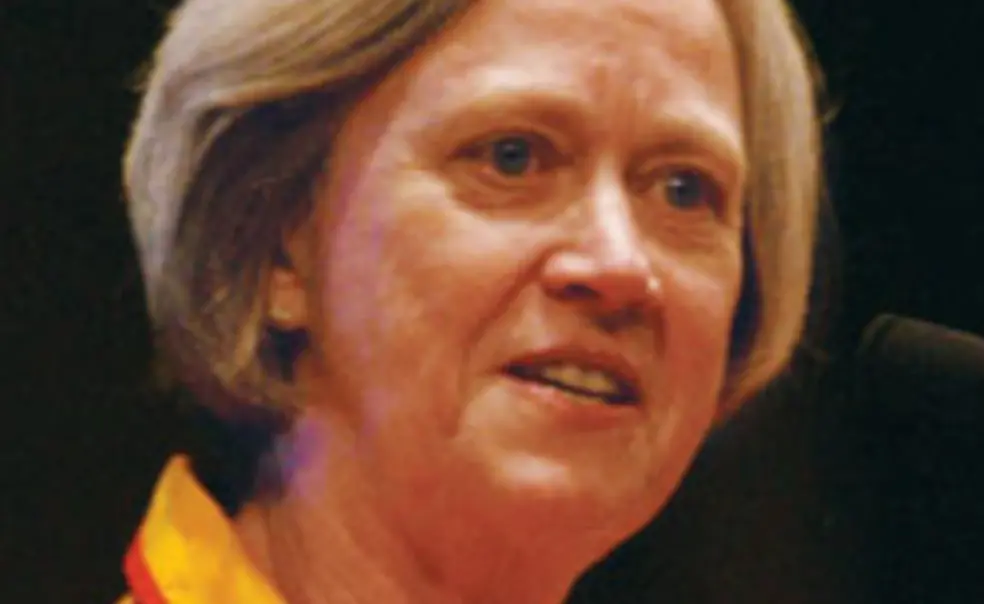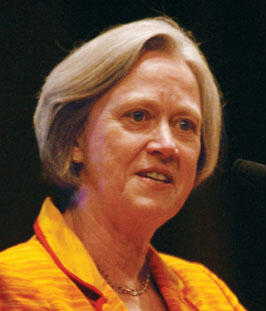Tilghman defends investment policies
As the endowment drops 23.7 percent, University’s budget-cutting will continue
Princeton’s endowment declined $3.7 billion to $12.6 billion in the year ending June 30, a 23.7 percent drop, President Tilghman said Sept. 29. In a letter to the University community, Tilghman said that Princeton continues to face “significant challenges, but we have made excellent progress this past year.”
The University has reached its savings goal of $88 million for the current academic year, Tilghman said, and is planning an additional $82 million in cuts from the 2010–11 budget. Although 145 staff members accepted a retirement incentive program, layoffs still will be required, she said, but the number will be “significantly less” than at some of Princeton’s peer institutions. Provost Christopher Eisgruber ’83 said the number of University employees already had dropped by more than 100 before the retirement program’s impact was felt, citing an aggressive vacancy-management program.
While the endowment’s value did not approach the 30 percent decline that had been feared in April, Tilghman said that Princeton still is spending more than is prudent for the long-term financial health of the University. “This is clearly not a time to relax, but rather to sustain the budgetary discipline that will protect the University’s core programs now and in the future,” she wrote. More spending cuts for 2011–12 cannot be ruled out, she said.
Tilghman noted that some have criticized the strategy of the Princeton University Investment Co. (Princo) as too risky, particularly since the endowment supports 48 percent of the $1.34 billion operating budget.
“With regard to the issue of risk, our policy of broad diversification of asset classes, including relatively illiquid asset classes such as private equity, independent return, and real assets, has, until last year, provided effective hedges against risk, as the values of asset classes tended to rise and fall independently of one another,” she said.
Last year’s financial crisis was a reminder “that there is no investment approach that could fully protect an endowment against the severest of global downturns” while providing returns that are high enough “to preserve the purchasing power for future generations,” Tilghman said.
She said that even after last year’s decline, the endowment’s 10-year annualized rate of return is about 9.7 percent, which she said “puts us in the top three or four of the 40 largest endowments in terms of long-term performance.” While some universities suffered endowment losses lower than Princeton’s last year, she said, they also had much lower annualized returns over the last decade.
A “more traditional approach” to investing would have led to an endowment about half its current size and would not have provided for “critical” initiatives like the no-loan financial-aid policy and the expansion of the undergraduate student body, Tilghman said. “In other words, our pre-eminence has depended upon the risk/reward profile that Princo has adopted,” she said.
Tilghman noted that the directors of the Princo board, along with members of the finance committee of the University’s board of trustees, are reviewing Princeton’s overall investment strategy and ways “to further buffer the University from future severe downturns.” Thus far, she said, the review suggests that “marginal, not radical,” changes may be needed.
The importance of maintaining enough liquidity within Princo to support the University budget with operating funds on a quarterly basis has been heightened, she said. “The pressure on liquidity was exacerbated by having a significant percentage of Princo’s resources in illiquid investments, and the looming (but largely unrealized to date) prospect of significant capital calls from its external managers that we would be legally obligated to meet,” she said.
While she stressed that the University has had more than enough liquidity to support the operating budget and meet its contractual obligations, “providing that liquidity would have required selling equities at unattractive prices.”
To preserve the long-term purchasing power of the endowment, she said, the University did not transfer funds from the endowment to the operating budget in the spring. Instead, working capital for operating expenses came from other sources, including the January sale of $1 billion in bonds. Carolyn Ainslie, vice president for finance and treasurer, said the University expects to avoid making cash withdrawals from the endowment again this year.
One result is that the $12.6 billion value of the endowment reflects the year’s investment returns and the addition of new gifts, “but unlike most years it does not reflect cash withdrawals for spending from the endowment,” Tilghman said.













No responses yet